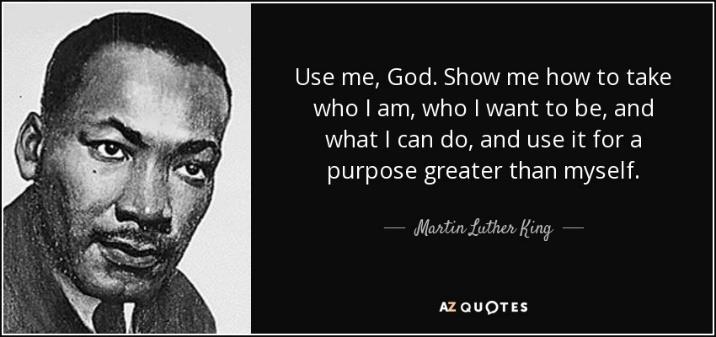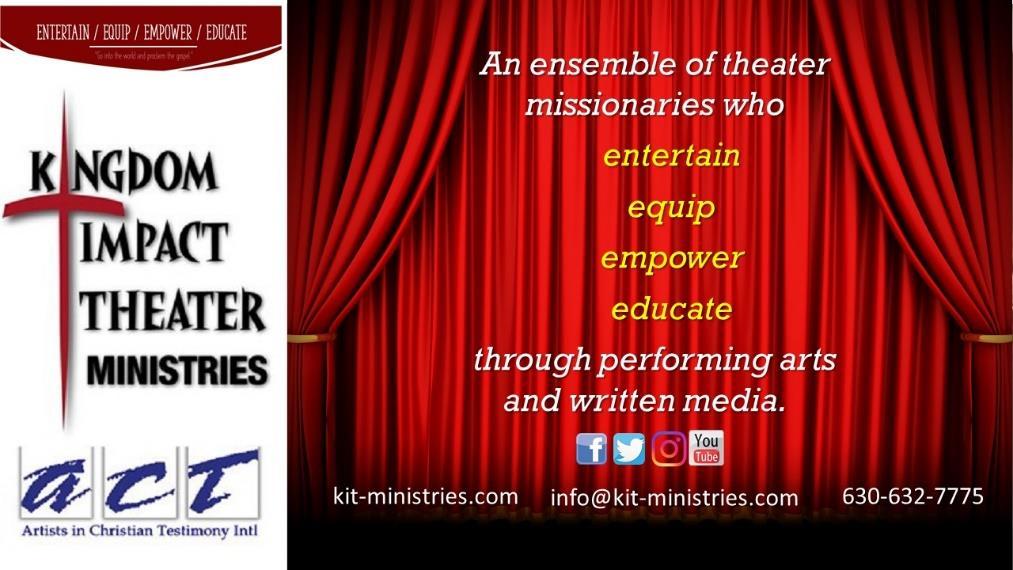
9 minute read
Your Stroll Down King Street
Things To Do
• Stroll (or drive through) a Martin Luther King Street near you. What do you observe? Take photos or sketch images.
Advertisement
• Visit a Martin Luther King or Coretta Scott King community center near you. What activities interest you?
• What national or regional monuments have you visited that honor Rev. or Mrs. King? Plan a live or virtual trip.
1723 Roosa Lane Elk Grove Village, IL 60007 www.kit-ministries.com 630-632-7775
APPENDIX
The Author’s Final MEMos (questions from his journals)
The seeds for this script were first planted the evening of April 4,1968 at a hotel in Indianapolis, Indiana. As his birthday present, the firstterm mayor of the city later six-term U.S. Senator Richard Lugar, was honoring our high school basketball team for finishing second in the state tournament. The mayor was an alumnus of the school. I was a freshman.


My Instamatic photo of the mayor celebrating with us, while down the street…
APRIL 4, 1968: Of Basketball and Birthdays
The banquet hall was packed with a who’s who of the city’s media, politicians and athletes. The night was festive, as birthday parties ought be. When the party began, few among us knew that the mayor’s smile was not a birthday grin. It was a mask. His game face. Lugar, a Republican, was struggling to withhold that he had been in communication with Sen. Robert Kennedy, a Democrat, who was scheduled to make a Presidential campaign speech in a neighborhood park a mile away He had been trying to convince Kennedy not to go, and not to tell the audience what they both had just discovered: While we in Indy were getting ready for the celebration, celebrated civil rights leader Rev. Dr. Martin Luther King had been shot dead in Memphis, Tennessee.
Nevertheless, in what is recognized as one of the great extemporaneous speeches in U.S. political history, Kennedy announced King’s assassination to the mostly black crowd, including some schoolmates who skipped the banquet. Kennedy’s speech is credited with helping Indianapolis remain peaceful while other large cities in the nation burned in rioting reaction to the murder. The strain of the evening was seen on his face among our classmates who saw Kennedy at the park, and some who saw him afterwards at the hotel where he was staying…which also hosted our banquet.
1723 Roosa Lane Elk Grove Village, IL 60007 www.kit-ministries.com 630-632-7775
FIRST IMPACT
That evening became personal political wakeup call; a bell rung further when Kennedy himself was gunned down two months later and died on the night of the seniors’ graduation.
The next year our school held a commemorative assembly honoring King. The assembly included discussions about whether his birthday should become a holiday, and student essays in the school’s daily newspaper. Questions were raised as:
• Should the U.S. honor a controversial citizen who had media charisma but could also be considered a threat to national security? • If so, would the holiday be distinct in how the Rev. King would be honored? Or, would the holiday be another commercialized day off?
The holiday conversation continued over the years as I covered legislatures debating the issue, later as the nation finally acknowledged, in 1983, that King’s birthdate, January 15, 1929, could be declared a Federal holiday and rolled into the new conceit of creating three-day weekends. Meanwhile the date, and countless streets, buildings and artwork began appearing across the nation in honor.
THE FAMILY THAT TOURS TOGETHER…
Into adulthood, travelling for pleasure and work, I often found myself at Martin Luther King Memorials, often as family affairs.
My first post-college trip with my parents was to Dr. King’s crypt in Atlanta ten years after his death; and, in masked-up pandemic America, went on a blitzkrieg date with my wife to the same locale, now expanded to be the King Center celebrating the commitment to non-violence of the pastor and his widow, Coretta Scott King, whose remains rest beside him.



1723 Roosa Lane Elk Grove Village, IL 60007 www.kit-ministries.com 630-632-7775
With my daughter’s eighth-grade class, I found myself at his memorial statue in Washington a few weeks after it was unveiled. I’ve made a point of stopping at the statue for reading, reflection and observing people with spouse, in-laws, and ministry colleagues whenever I’m in the nation’s capital. I’ve pondered his bust with our teenaged daughter in the U.S. Capitol, escorted my wife through the memorial in park in Indianapolis where Robert Kennedy announced King’s death. A later trip to the homestead, alone, coincided with a commemorative appearance by Kennedy widow, Ethel, and a son. I made a point of going to the park.
On separate trips to Memphis, I found myself standing along the balcony where he was slain at the Lorraine Hotel, and outside the sniper’s nest across the street from when James Earl Ray fired the fatal shot.
KINGS OF THE ROAD
More sobering than the guided or unofficial tours to historic sites have been the innumerable times I’ve unexpectedly found myself driving or walking along a King Street in some city in any of the 49 United States in which I’ve travelled.
When I noticed a pattern, like a kid playing the license plate game on a family drive, I’d make note of the variations on the name: “King Dr.” “King Drive,” “King Street,” “King Road,” “King Blvd.” “MLK.” The full moniker: “Dr. Martin Luther King Jr. Drive,” squeezed onto a standard-sized street sign. The pattern amused me.
I then began taking notice of other patterns, ironies. How I could go from, “Almost EV’BODY in this state has a Martin Luther King Street!” to weeks without seeing ONE.

I also began noting: other ironies I did not find amusing:
• how the streets were in assorted states of upkeep; • the frequency with which King Street was mentioned in a crime report; • when uplifting test scores or athletic successes at schools named for King were offset by reports of schools named King being closed, graffiti-tagged, or struggling with issues of violence involving black students and…well, struggling with issues of violence.
What must Dr. King be thinking, I often wondered, if he could see this?
1723 Roosa Lane Elk Grove Village, IL 60007 www.kit-ministries.com 630-632-7775
MODERN TIMES
At the same time, Martin Luther King celebrations became ubiquitous – all over the place – on his birthday and few days afterwards. Then, like Christmas, Martin Luther King and his ideals disappeared from the public - if not out of sight, at least to simmer on a black burner…often until a few days in February where he received his obligatory a Black History Month rerun. My mind whirred editorially:
• The King holiday had become what we feared when first writing about it in high school in 1969…just another three-day extended time off? • King’s name became invoked by politicians pandering votes, to the extent of justifying their heinous behavior in the spirit. • “I have a dream” became both a nightmare and a cliché.
The refrain, “What must Dr. King be thinking if he could see this?” echoed afresh as the Black Lives Matter movement emerged in 2012, gained new fervor in 2017, and exploded in the streets during 2020.
BLACK LIVES & OTHER MATTERS
Clergy across the nation began aligning with the issues the BLM founders brought up, sadly because those issues are largely unresolved from when they were the essence of the work of Rev. King and his colleagues -- Ralph Abernathy, Joseph Lowery, Fred Shuttleworth -- who formed the Southern Christian Leadership Conference a generation earlier…and unchanged from the generation that preceded and inspired King. Issues as overzealous law enforcement, economic inequity, interpersonal disrespect, corporate and educational disparity.

Yet, agreeing with issues, stark differences exist between the images of pastoral leadership in the eras of the SCLC and BLM. Debate surrounds methods, occasionally theological, that separated King from Malcolm X (and Booker T. Washington and W.E.B. Dubois before them); that differentiated between the non-violent movement and the combative Black Panther Party.

From those perspectives – the social and Scriptural – came the question: “Where would Martin Luther King be seen in Black Lives Matters march photos?”
A connected query for Christ-followers aligning with BLM issues is,
“How does the work of Jesus Christ inform their actions and rhetoric as the Scriptures of the King of Kings guided Rev. Dr. King?”
1723 Roosa Lane Elk Grove Village, IL 60007 www.kit-ministries.com 630-632-7775
THE DREAM SPEECH REVISITED
A dominant image at The King Center in Atlanta is a symbolic rolling river which surrounds the markers of Rev. King and his wife, Coretta. The water overflows words inscribed on steps, as he spoke them in his celebrated “I Have a Dream” speech during the March on Washington in 1963.
“We will not be satisfied until justice rolls down like water and righteousness like a mighty stream.”
As with many elements of poignant commentary, historic extractions often cause us to focus on the popular commentary and lose context. This is particularly true when the context is based in Scripture. These words are not King’s, but his inclusion of writings of the prophet Amos, recorded in the Hebrew Bible (a.k.a., the Old Testament).

Interestingly the words on the steps are a poetic license of King’s quoting scripture. “We will not be satisfied” is inscribed. But King said, and Amos wrote, “We ARE not satisfied.” A subtle difference, yet in these editorial eyes, reading in present tense rather than future tense gives more power to the words of God speaking NOW. King’s model for contemporary clergy is that he did not refrain from publicly quoting Scripture to address social ills. Therefore, the question to be discussed on nightly talking-programs or impromptu press conferences is this:
“What’s the difference between social justice and Biblical justice?”
While the question is applicable to address inequitable systems and racial discord, it seems an equally viable challenge to his own congregations at a time when self-identity was evolving from “Negro” to “Black” and raises another contemporary query:
What would Dr. King say about violence within the black community?
These questions and issues may seem overwhelming. Yet, examining Rev. King’s “Dream” speech beyond its popular title offers insight to overcome. “Out of the mountain of despair,” he said, “a stone of hope."
It seemed only right, then, to turn to Rev. & Mrs. King for that hope. And so, Coretta encourages her husband, “Tell them about the dream, Martin!” Wherein we imagine: What is Martin Luther King’s dream for America today? And we ask you, “What is your dream? What will you do to make it reality?
1723 Roosa Lane Elk Grove Village, IL 60007 www.kit-ministries.com 630-632-7775







